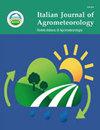播期对温带秋播甜菜抽薹及霜害的影响
IF 0.8
4区 农林科学
Q2 AGRONOMY
Italian Journal of Agrometeorology-Rivista Italiana Di Agrometeorologia
Pub Date : 2023-08-03
DOI:10.36253/ijam-1862
引用次数: 0
摘要
甜菜主要在温带相对凉爽的地区种植,春季播种,但在一些冬季温和的地中海地区,作物在秋季播种。由于全球变暖,甜菜的秋季种植正逐渐扩展到冬季相对寒冷的新地区。幼苗损失和抽薹是限制秋季甜菜在新地区种植的两个因素。本研究的目的是确定播种日期对(i)田间出苗的持续时间和速率,(ii)甜菜早期生长期间的酚期,(iii)幼苗的数量性状,以及(iv)秋播甜菜的抽薹发生和霜冻的影响。在伊朗卡拉杰和马什哈德地区,采用随机完全区组设计进行了田间试验,以确定2017/18年和2018/19年秋季播种甜菜的合适播种日期,这两个地区的冬季都相对寒冷。本试验采用一个耐抽薹品种和六个播期处理。结果表明,要达到子叶的生长阶段,分别需要2、4、6、8、10、12、14和16片叶子163、200、321、418、500、600、639、700和757个生长度日(GDD)。随着播种时间的推迟,平均出苗时间和出苗速度分别增加和减少。研究结果表明,调整冬季甜菜的播种日期,以便当温度达到可抽薹的有效温度(6-8°C)时,该植物已经获得约300至400 GDD。此时,甜菜的生长阶段和最大根径分别约为4-6片叶子和0.11-0.27厘米。在14至16叶期(≥700-750 GDD)后,因低温而死亡的植株百分比可以忽略不计。尽管在4-6叶期(300-400 GDD)霜冻损失的风险更高,但接受更高的损失是合理的,因为抽薹的可能性更低。本文章由计算机程序翻译,如有差异,请以英文原文为准。
Effects of sowing date on bolting and frost damage to autumn-sown sugar beet (Beta vulgaris L.) in temperate regions
Sugar beet is mostly cultivated in relatively cool regions of the temperate zones by sowing in spring, but in some Mediterranean areas with mild winters, the crop is sown in autumn. Due to global warming, autumn cultivation of sugar beet is gradually extending towards new areas that are still characterized by relatively cold winters. Seedling loss and bolting are two factors limiting the adoption of autumn sugar beet cultivation in new areas. The objectives of this study were to determine the effects of sowing date on (i) duration and rate of field emergence, (ii) phenological stages of sugar beet during early growth, (iii) quantitative traits of seedlings and (iv) bolting occurrence as well as frost killing of autumn-sown sugar beet. Field experiments were conducted in a randomized complete block design to determine the appropriate sowing date for autumn-sown sugar beet in 2017/18 and 2018/19 in the Karaj and Mashhad regions of Iran, which are both characterized by relatively cold winters. The experiment was conducted with a bolting-resistant cultivar and six sowing date treatments. The results showed that to reach plant growth stages of cotyledon, 2, 4, 6, 8, 10, 12, 14 and 16 leaves, 163, 200, 321, 418, 500, 600, 639, 700 and 757 growing degree days (GDD), respectively, were required. The average duration and speed of seedling emergence increased and decreased, respectively, with delay in sowing. The results suggest adjusting the sowing date of winter sugar beet so that when temperatures effective for bolting (6-8 °C) occur, the plant has already received about 300 to 400 GDD. At this time, the growth stage and the largest root diameter of sugar beet are approximately 4-6 leaves and 0.11-0.27 cm, respectively. After 14- to 16-leaf stage (≥700-750 GDD), the percentage of killed plants due to low temperatures were negligible. Although, the risk for frost losses is higher at 4- to 6-leaf stage (300-400 GDD), accepting higher losses is justified by a lower probability of bolting.
求助全文
通过发布文献求助,成功后即可免费获取论文全文。
去求助
来源期刊

Italian Journal of Agrometeorology-Rivista Italiana Di Agrometeorologia
AGRONOMY-ENVIRONMENTAL SCIENCES
CiteScore
2.10
自引率
8.30%
发文量
6
期刊介绍:
Among the areas of specific interest of the journal there are: ecophysiology; phenology; plant growth, quality and quantity of production; plant pathology; entomology; welfare conditions of livestocks; soil physics and hydrology; micrometeorology; modeling, simulation and forecasting; remote sensing; territorial planning; geographical information systems and spatialization techniques; instrumentation to measure physical and biological quantities; data validation techniques, agroclimatology; agriculture scientific dissemination; support services for farmers.
 求助内容:
求助内容: 应助结果提醒方式:
应助结果提醒方式:


